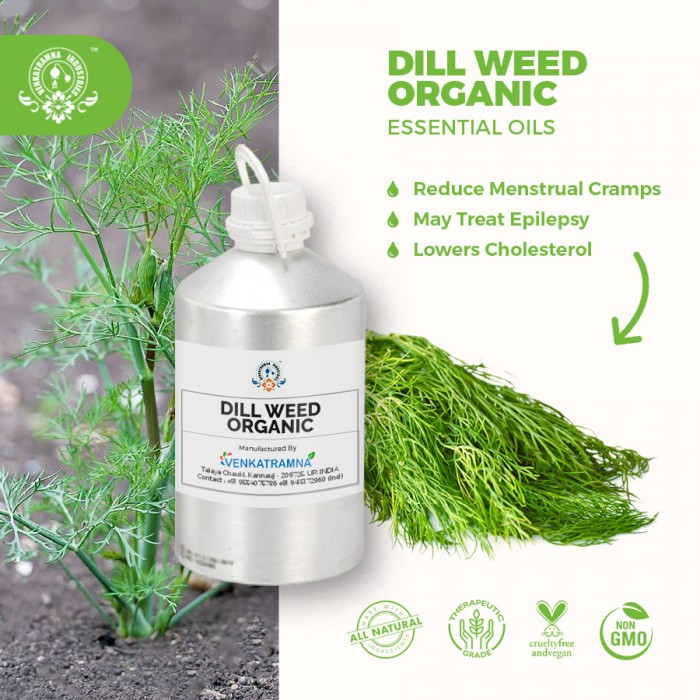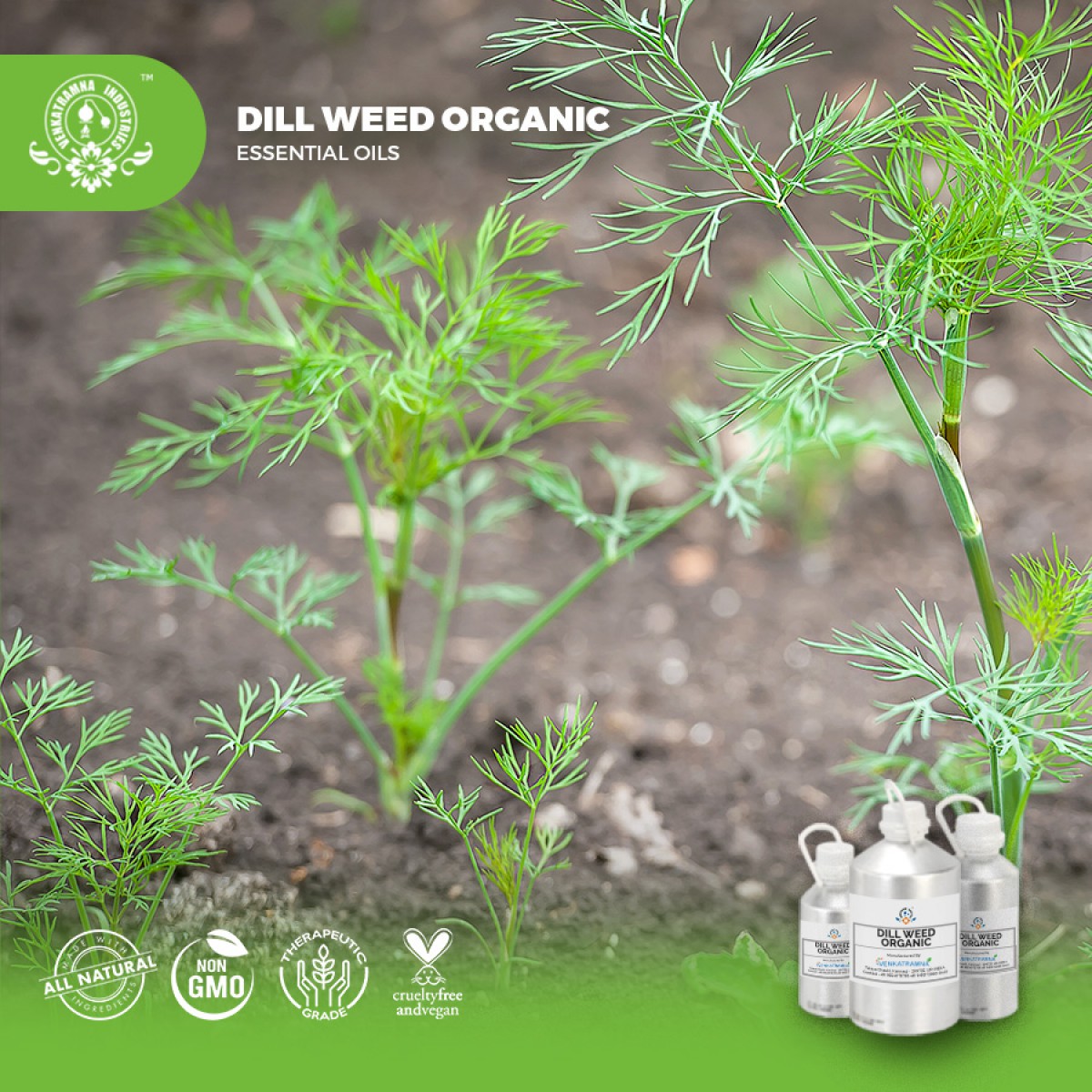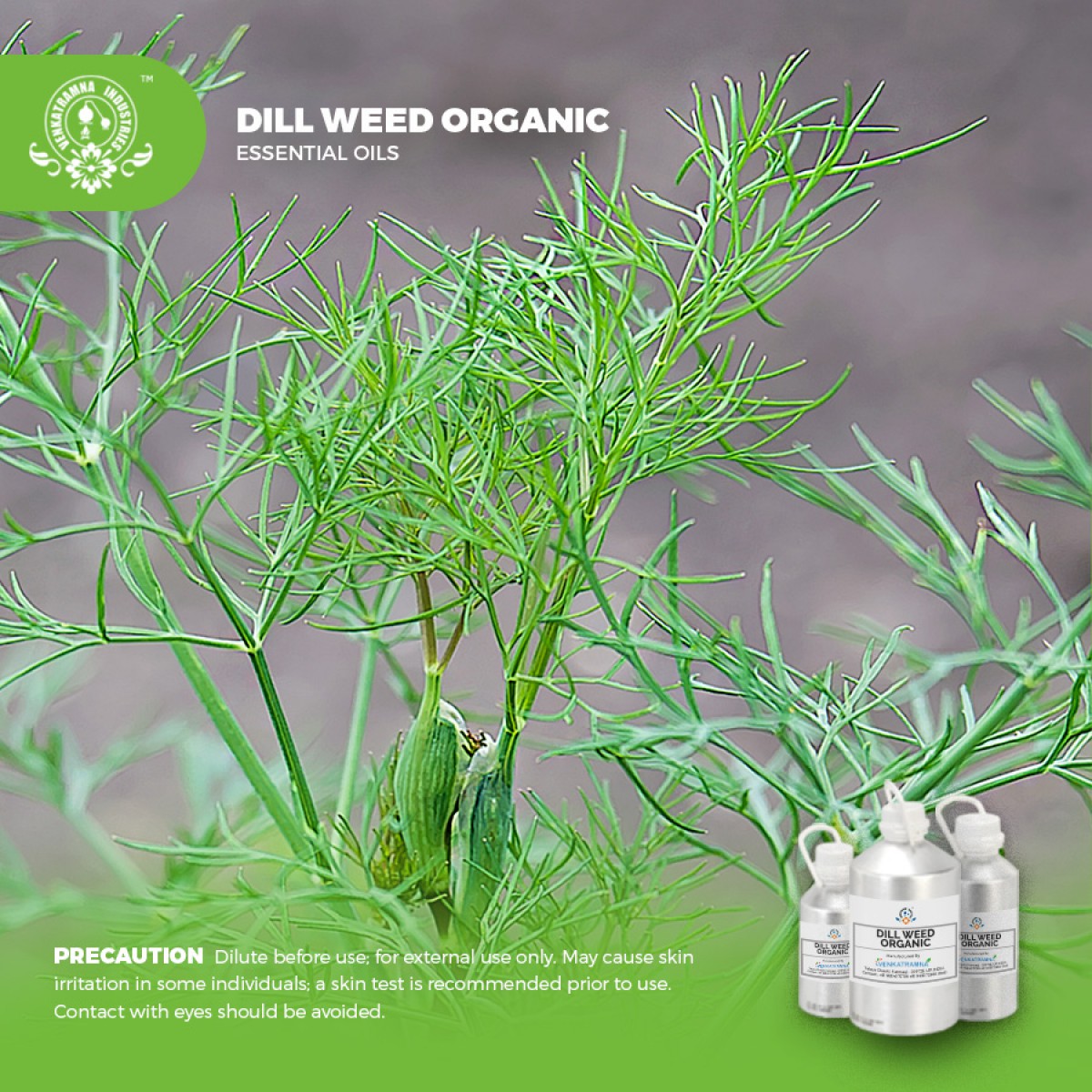Botanical Name: Anethum graveolens L. Common name: Dill Herb Plant fa Read More
|
Botanical Name: |
Anethum graveolens L. |
|
Common name: |
Dill Herb |
|
Plant family: |
Apiaceae |
|
Genus: |
Anethum |
|
Appearance/Color: |
A thin,
colourless to pale yellow liquid that darkens over time. |
|
Odor: |
A middle note of medium aroma, Organic Dill Weed Essential Oil is
fresh and sweet with qualities similar to anise seed. |
|
Blends With: |
Dill Weed works well with other spice oils, Elemi, Peppermint,
and Caraway. |
|
Origin: |
Bulgaria |
|
Source: |
Leaves |
|
Method of
Extraction: |
Steam Distillation |
The genus name Anethum is derived from Greek word aneeson or
aneeton, which means strong smelling. Its common use in Ayurvedic medicine is
in abdominal discomfort, colic and for promoting digestion. Ayurvedic
properties of shatapushpa are katu tikta rasa, usna virya, katu vipaka, laghu,
tiksna and snigdha gunas. It cures ‘vata’, ‘kapha’, ulcers, abdominal pains,
eye diseases and uterine pains. Charaka prescribed the paste of Linseed, castor seeds and shatapushpa (A. graveolens) pounded with milk for external
applications in rheumatic and other swellings of joints. Kashyapa samhitaa
attributed tonic, rejuvenating and intellect promoting properties to the herb (A. graveolens). It is used in Unani medicine in colic,
digestive problem and also in gripe water. Anethum graveolens L.
is used in the preparations of more than 56 ayurvedic preparations, which
include Dasmoolarishtam, Dhanwanthararishtam, Mrithasanjeevani,
Saraswatharishtam, Gugguluthiktaquatham, Maharasnadi kashayam, Dhanwantharam
quatham and so on. Anethum graveolens L.
(dill) believed to be the native of South-west Asia or South-east Europe. It is
indigenous to Mediterranean, southern USSR and Central Asia. Since Egyptian
times, Anethum has been used as a condiment and also in medicinal purposes. It
was used by Egyptian doctors 5000 years ago and traces have been found in Roman
ruins in Great Britain. In the Middle Ages it was thought to protect against
witchcraft. Greeks covered their heads with dill leaves to induce sleep.
Anethum sowa L. (Bengali-Shulfa) belonging to the family Apiaceae (Umbelliferae), comes under genus Anethum and it is an annual and winter spice crop in Bangladesh. It is mostly grown in the northern part of Bangladesh. A variant called Indian dill or sowa (Anethum sowa Roxb.) is largely cultivated in Bangladesh, India, Egypt and Japan. Indigenous people consume it as a spice for a flavoring agent in food preparation. The herb grows ordinarily 2–2.5 ft. in height with small feathery leaves, tapped and branched roots. The chemical composition of the essential oil of the two chemotypes i.e. European dill (Anethum graveolens L.) and Indian dill (Anethum sowa L.) are differentiated mainly by the apiol and carvone content. Anethum sowa is rich in apiol whereas Anethum graveolens is rich in carvone. The typical flavor of dill herb oil is due to ?-phellandrene, limonene and dill ether (anethofuran). The green herb, seeds and its roots are used as folkloric medicine e.g. aromatic, carminative especially useful in the treatment of flatulence, colic and hiccups of infants and children. Recently, it has been reported that seed essential oils are the potential source of antioxidant and also have antimicrobial and antispasmodic properties.
DISCLAIMER
The complete range of conditions
or methods of use are beyond our control therefore we do not assume any
responsibility and expressly disclaim any liability for any use of this
product. Information contained herein is believed to be true and accurate however,
all statements or suggestions are made without warranty, expressed or implied,
regarding accuracy of the information, the hazards connected with the use of
the material or the results to be obtained from the use thereof. Compliance
with all applicable federal, state, and local laws and local regulations
remains the responsibility of the user.
The FDA has not evaluated the
statements on this website. No claims are made by Venkatramna Industries as to
the medicinal value of any products from vriaroma.com or by us. The information
presented here is for educating our customers about the traditional uses of
essential oils and is not intended to diagnose, treat, cure, or prevent any
disease. You are responsible for understanding the safe application of these products.
If you have any questions, please call or email us for further information.
As per NAHA guidelines, New Directions Aromatics
(NDA) does not recommend the ingestion of essential oils. It is imperative to
consult a medical practitioner before using Essential Oils for therapeutic
purposes. Pregnant and nursing women and those taking prescription drugs are
especially advised not to use this product without the medical advice of a
physician. The oil should always be stored in an area that is inaccessible to
children, especially those under the age of 7.
Anethum graveolens L. (dill) has been used in ayurvedic
medicines since ancient times and it is a popular herb widely used as a spice
and also yields essential oil. It is an aromatic and annual herb of apiaceae
family. The Ayurvedic uses of dill seeds are carminative, stomachic and
diuretic. There are various volatile components of dill seeds and herb; carvone
being the predominant odorant of dill seed and ?-phellandrene, limonene, dill
ether, myristicin are the most important odorants of dill herb. Other compounds
isolated from seeds are coumarins, flavonoids, phenolic acids and steroids.
Dill Seed Essential Oil in
Pharma
Different parts of Anethum
sowa L. is used in folk medicine as a carminative for the treatment of
flatulence, colic and hiccups of infants and children, antioxidant,
antimicrobial and antispasmodic agent. Anethum is used as an ingredient in gripe
water, given to relieve colic pain in babies and flatulence in young children.
The seed is aromatic, carminative, mildly diuretic, galactogogue, stimulant and
stomachic the essential oil in the seed relieves intestinal spasms and griping,
helping to settle colic. The carminative volatile oil improves appetite,
relieves gas and aids digestion. Chewing the seeds improves bad breath. Anethum stimulates milk flow in lactating mothers,
and is often given to cattles for this reason. It also cures urinary
complaints, piles and mental disorders.
Essence of Dill Seed Essential
Oil
Anethum seeds are used as a spice and its fresh and dried
leaves called dill weed are used as condiment and tea. The aromatic herb is
commonly used for flavoring and seasoning of various foods such as pickles,
salads, sauces and soups. Fresh or dried leaves are used for boiled or fried
meats and fish, in sandwiches and fish sauces. It is also an essential
ingredient of sour vinegar. Dill oil is extracted from seeds, leaves and stems,
which contains an essential oil used as flavoring in food industry. It is used
in perfumery to aromatize detergents and soaps and as a substitute for caraway
oil.
COMMON USAGE
·
Promotes digestion
·
Reduces menstrual cramps
·
Helps reduce depression
·
Lowers cholesterol
·
May act as a natural bug repellent
·
May treats epilepsy
·
Provides a source of energy and aids in
·
Digestion through beneficial fatty acids
·
Contains antimicrobial effects
· Protects against free radicals
Ingredients:
|
S.No |
Key Constituents |
Strength (%) |
|
1 |
(P)-carvone |
31.6-42.4 |
|
2 |
a-phellandrene |
18.2-30.3 |
|
3 |
(P)-limonene |
22.5-24.9 |
|
4 |
Anthofuran (dill ether) |
5.6-6.6 |
|
5 |
b-phellandrene |
2.3-3.3 |
|
6 |
(E)-dihydrocarvone |
0.5-1.9 |
|
7 |
(Z)-dihydrocarvone |
0.8-1.4 |
|
8 |
p-cymene |
1.0-1.1 |
TOXICOLOGICAL
INFORMATION
Safety Summary
·
Hazards: drug interaction.
·
Cautions (oral): diabetes medication.
·
Inhalation: Inhalation of high
concentrations of vapor may result in irritation of eyes, nose and throat,
headache, nausea, and dizziness
Organ-specific effects
·
Adverse skin reactions: Undiluted Indian
dill seed oil was moderately irritating to rabbits, but was not irritating to
mice or pigs; tested at 4% on 25 volunteers it was neither irritating nor
sensitizing. It is non-phototoxic. Skin contact Repeated or prolonged contact
can cause redness, irritation and scaling of skin (Dermatitis). Adverse skin
effects should be prevented by normal care and personal hygiene.
·
Cardiovascular effects: Dill oil reduced
blood glucose levels in both normal and alloxan-diabetic rats following sc
injection at 27 mg/kg.
·
Ingestion: Low order toxicity causing
irritation of the stomach and intestines which results in nausea and vomiting.
·
Eye contact: May irritate eyes.
Systemic effects
·
Acute toxicity: Dill weed oil acute oral
LD50 in rats 4.04 mL/kg; acute dermal LD50 in rabbits>5 g/kg.
·
Carcinogenic/anticarcinogenic potential:
Dill weed oil induced chromosome aberrations in human lymphocytes and also was
genotoxic in fruit flies. However, it significantly induced glutathione
S-transferase activity in mouse tissues, as do (þ)-carvone, (þ)-limonene and
anethofuran . (þ)-Carvone is not a rodent carcinogen; both carvone and
(þ)-limonene display anticarcinogenic activity.
·
Drug interactions: Antidiabetic
medication, because of cardiovascular effects, above.
ECOLOGICAL
INFORMATION
·
Toxic to aquatic organisms, may cause long-term
adverse effects environment. Avoid any pollution of ground, surface or
underground water.
·
Persistence & degradability
Biodegradability: no degradability data is available; the substance is
considered as not degrading quickly.
·
Bioaccumulation Potential No additional data
available.
·
Mobility in soil No additional data available.
·
Results of PBT and vPvB Assessment No additional
data available.





 MSDS-Dill_weed.pdf
MSDS-Dill_weed.pdf




